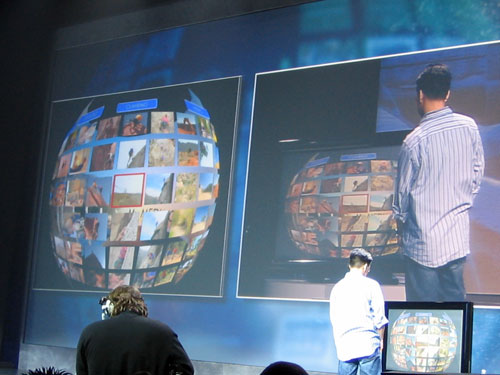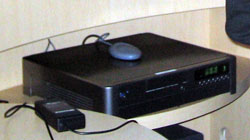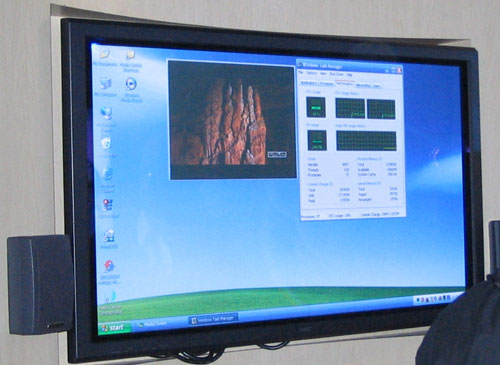Consumer Electronics Show 2005: AT's Coverage
by Anand Lal Shimpi on January 10, 2005 3:49 AM EST- Posted in
- Trade Shows
Dual Core at 3.0GHz - Working Now
Starting off with the PC side of things, Intel was far more present at CES than AMD, which is what we expected given the higher level of involvement from Intel on the CE front.
During Craig Barrett's keynote on the first day of CES, one of the demos involved a media center PC (not MCE) showcasing an interesting method of navigating video content on the PC: using hand gestures.

The spherical image on the left was basically your channel listing, with each one of those little windows displaying a full frame rate video stream, the sum of which was all of the channels you could possibly watch. You could rotate the channels left or right by moving your hands in the appropriate direction, and you could select which channel you wanted to watch by pointing at it. The demo wasn't flawless but Barrett promised that the technology being demoed was something that would be available 12 months from now.
Whether he was talking about every aspect of that particular PC or just its dual core Smithfield based processor is up to anyone's speculation. Unfortunately Barrett didn't disclose too much about the CPU specs of the system other than it was a dual core unit.

Intel's Dual Core Smithfield Pentium 4 x30 platform with both cores running at 3.0GHz
Luckily at Intel's booth we were able to get a glimpse of said system and found out it was a fully functional 90nm Smithfield running at 3.0GHz. It's about time Intel had a running dual core demo, it was beginning to look like only AMD would be able to pull off dual core.

Task Manager shows the two cores in action, note that there is no Hyper Threading on Dual Core CPUs so there are only two physical CPUs listed
Bring up of Intel's dual core seems to be pretty strong and everything is on track for a release at the end of 2005. We did get confirmation that the dual core CPUs would not work on existing 925X and 915 based motherboards, not without changes to their design. While we would normally be disappointed, the fact of the matter is that very few people bought 925X and 915 based motherboards so it's not too big of a deal.
We also asked Intel if they had any tricks up their sleeve for regaining the definitive performance crown this year - unfortunately their answer was no. It appears that a lot of upper management at Intel is a bit astounded by the success of Centrino, noting that it is a full blown success achieved on features and a full platform and not purely performance. There's also this idea that performance right now is good enough for most desktop users, and fighting over a handful of percentage points that won't be appreciated is a silly battle to win. So for the near future at least, it seems like what we've published in previous Intel roadmaps is all we're going to see from them. What remains to be seen is if AMD will be able to continue to convert Intel's lack of focus on absolute performance leadership into marketshare for AMD.
Intel also seems confident that dual core will bring noticeable performance gains to the desktop user, citing that while application support may not be there that the OS and multitasking experiences will be greatly improved to the point that once you've used dual core you'll never go back. Having personally used multiprocessor systems as my main workstations for years now I can attest to the benefits of multiprocessors, however more than anything we're going to need a good way of quantifying the performance benefits with something else than an Intel script that runs an antivirus scan while you defragment your hard drive.










48 Comments
View All Comments
quanta - Wednesday, January 12, 2005 - link
Isn't DLP design rather unreliable? After all, it involves mechanically moving millions of microscopic mirrors to create brightness, and there is no easy way to oil these tiny joints when the chip gets old. Since each mirror is moving thousand of times a second, dead pixels can develop rather quickly. As a side effect of moving all these mirror, won't the chips get noisy as well?PrinceGaz - Wednesday, January 12, 2005 - link
Heh, as soon as I read the bit about mobo manufacturers confirming what most of us already know; that nVidia has abandoned SoundStorm and it will not be returning in anything like its original form (DD encoding) in the forseeable future.Just because the Inq reports on something doesn't make it gospel truth, much of what they post is rumours and they have been known to be wrong in the past ;) As for the nVidia chairman saying SS is returning in a surprising form, that could mean just about anything except what some people here are hoping for. A return of the original SS or an updated version of it would be totally unsurprising so he is effectively ruling that out.
Could one of the SS zealots who believes it will make a return with PCIe please explain to me why it needs more bandwidth than what PCI can provide? Surely if the card is doing all the encoding, all that needs to be sent to it is the raw audio data which is minimal. Even the very highest quality 8-channel 32-bit 192khz sampling-rate uncompressed audio needs under 6MB/s of bandwidth which is easily handled by PCI, so I fail to understand why PCIe would make a difference. If there were sufficient consumer demand for a DD encoder, somebody would have already made one for PCI, so you're deluding yourself if you think the only reason they aren't available is that it needs the increased bandwidth offered by PCIe. Unless of course you have evidence which suggests otherwise and I'd be interested in reading it.
Rather than waiting for the return of SS, I suggest you buy a few decent cables and hook up your soundcard to your amplifier the normal way. Provided the soundcard has decent DACs, you'll enjoy higher quality sound than anything SoundStorm's dolby-digital output could provide.
linuxOwnzIfUrLeet - Tuesday, January 11, 2005 - link
#44,45...It's at sam's club:
It's made by infocus.
The web shows "InFocus® ScreenPlay 4805" but I'm not sure the 4805 was the one. Their web is not the same stuff as what you have in the store.
bob661 - Tuesday, January 11, 2005 - link
#44I was going to ask the same thing.
#39
SS is dead. Move on, nothing to see here.
OrSin - Tuesday, January 11, 2005 - link
14# Where can I get a 76 DLP for 1400.Shit where can I get decent 76" HD of any kind of for $1400. I live in the USA. I really want to know. My 42in Toshiba HD is not cutting it and it cost me $1000.
xxeper - Tuesday, January 11, 2005 - link
I love how you talk about how "bulky" the Windows Mobile [PocketPC, MPx] are while at the same time basically petting and licking the Windows Mobile smartphone [C500]. Did you even bother to pick up the BENq or iMat Jam phones? or were you too busy whispering sweet nothings to your P.O.S. Audiovox?Live - Tuesday, January 11, 2005 - link
#13The X800 you are linking to costs 450$ when its supposed to sell for 250$. and only that brand is available.
Zebo - Tuesday, January 11, 2005 - link
AMD was curiously quiet throughout the show,----------------
Speak Softly and carry a big stick.:)
RyanVM - Tuesday, January 11, 2005 - link
#9, I read the exact same thing in Maximum PC three months ago.shinotenshi - Monday, January 10, 2005 - link
The design team was disbanded, however many sources have already reported that the team was reconstitued. The design won't be finished by luck would have it, at the time the sony ps3 is done. As i said before, i don't this is a coincidence. the interest of sony(ps3,blu-ray) and nvidia(pushing pci-e, other markets, consumer, pci-e sound cards), are converging. If they can build a chip that can encode either DD++ or DTS+++ it would be an econnomic windfall.